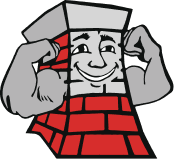Is My Fireplace Safe to Use?
 Autumn is right around the corner. Soon the leaves will be turning and you’ll be looking forward to spending the evening in beside a roaring fire drinking a mug of hot cider. Before you light up your fireplace for the first time this season, it’s smart to ask “Is my fireplace safe?”
Autumn is right around the corner. Soon the leaves will be turning and you’ll be looking forward to spending the evening in beside a roaring fire drinking a mug of hot cider. Before you light up your fireplace for the first time this season, it’s smart to ask “Is my fireplace safe?”
Almost 14,000 house fires a year originate from fireplaces. Many of these fires could have been prevented if the homeowners or renters had known more about fireplace safety and how to spot risks. Fireplaces can become unsafe for many reasons. Here are some pro-tips on how to make sure that your chimney is safe to use this fall:
1. Hire a chimney sweep to remove creosote buildups.
Creosote is a highly flammable chemical compound that builds up in chimneys. It’s created when combustion gases produced by burning wood interact with each other in the flue. It can look like a tar-like black or brown substance or like dark glass clinging to the walls of the flue.
Even a small buildup of creosote can be ignited by a stray spark. A large buildup of creosote can result in an explosive chimney fire. Tackling creosote removal as a D.I.Y. project is rarely successful. Without professional grade cleaners and the correct equipment, it can seem impossible to remove. A chimney cleaning log can make a chimney sweep’s job easier but it can still leave dangerous amounts of creosote in the chimney. That is why it is wise to hire a CSIA-certified chimney sweep to take care of it for you. They have the right equipment to get the job done.
The best time to hire a chimney sweep is at the end of the burning season in the spring or the beginning of the burning season in the fall.
2. Do a visual inspection of the chimney and fireplace.
A blocked or damaged chimney can also be a serious safety concern. A house fire isn’t the only risk. Hazardous chimney conditions can result in carbon monoxide poisoning. Carbon monoxide is one of the combustion byproducts in smoke. If it isn’t able to escape outside through the chimney, it can build up in your home. Symptoms of carbon monoxide exposure range from dizziness and shortness of breath to irreversible brain damage and death.
Most qualified chimney sweeps will do an inspection along with the cleaning to ensure that your chimney has no other safety risks. If you had your chimney cleaned in the spring or early summer, you should do a quick visual inspection yourself to make sure the chimney has not become obstructed or damaged.
What to look for outside on your chimney:
– A bird’s nest or other debris at the top of the chimney
– Crumbling or missing pieces of bricks or mortar on or around the chimney
– Tree limbs or branches close to the chimney
– Loose pieces of flashing (the metal edging that bridges the gap between the chimney and the roof)
– White staining on the masonry
– A sloping chimney crown (the cement block on top of the chimney)
– A missing or damaged chimney cap
What to look for inside in your fireplace:
When you are inside, grab a flashlight and look up the flue through the firebox.
– Make sure that the flue damper opens and closes
– Check that the damper seals closed without gaps
– Look for signs of obstructions like nests or lawn debris in the flue
 If you have a gas burning fireplace:
If you have a gas burning fireplace:
– Turn the gas valve off and on and test the igniter
– Make sure the logs or stones aren’t in a bad position
– Inspect the latch to make it closes and look for cracks in the glass doors
Follow these tips to make sure your fireplace is safe to use. Also, remember to only burn seasoned wood and never overload the fire!
If you notice any problems, contact a qualified chimney technician who can take a closer look and resolve the issue. We are here to help if you need us! Our CSIA-certified technicians serve homeowners and renters throughout Central Connecticut.


